When to Cut Back Peonies in the Fall
With their breathtaking blooms and lush foliage, peonies are beloved additions to any garden. These perennial beauties require regular care, and one essential task for maintaining their health and promoting abundant blooms is pruning. In this comprehensive guide, we will delve into the art of cutting back peonies in the fall, exploring the importance of this practice and providing you with all the information you need to ensure your peonies thrive year after year.
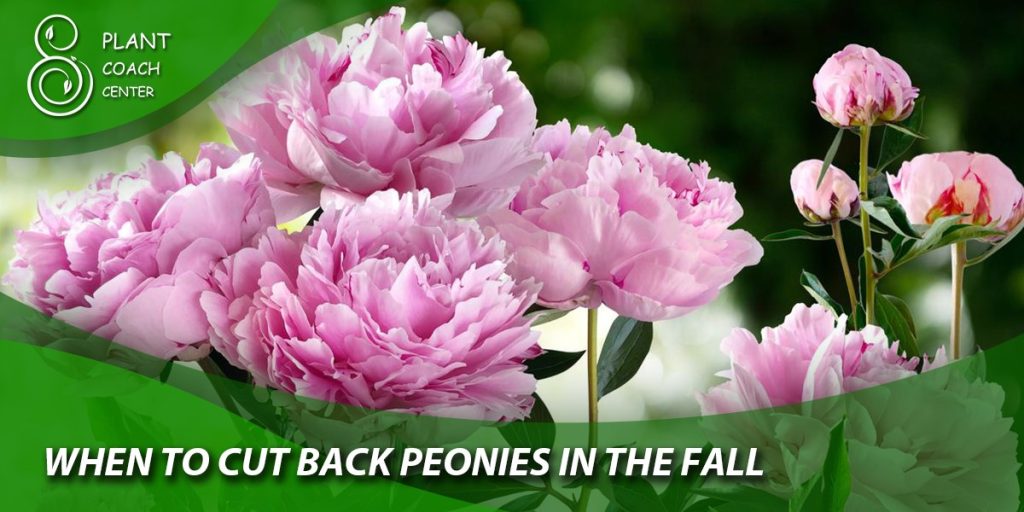
Understanding Peonies
Before we delve into fall pruning, let’s take a moment to understand the magnificent peony. Peonies belong to the Paeonia genus and are available in various stunning cultivars. These herbaceous or tree-like perennials grace gardens with their large, showy flowers in various colors, including shades of white, pink, red, and even yellow.
Peony Growth Cycle
To grasp the significance of fall pruning, it’s crucial to familiarize ourselves with the growth cycle of peonies. These plants go through several distinct stages throughout the year. Peonies emerge from their winter dormancy in spring and send up new shoots and leaves. As the weather warms, their buds begin to form, promising the arrival of breathtaking blossoms.
Throughout summer, peonies proudly display their stunning flowers. Bees and butterflies are drawn to their intoxicating scent and abundant nectar. Once the flowers have faded and the petals fall, the plants transition into the next phase of their cycle, focusing their energy on developing seed pods.
The Significance of Fall Pruning
Fall pruning plays a pivotal role in your peonies’ overall health and vitality. By cutting back the plant in autumn, you provide numerous benefits, including rejuvenating the peony, preventing disease, and preparing it for the challenges of winter.
Firstly, pruning helps rejuvenate the peony by encouraging new growth and maintaining its shape. Trimming away spent foliage and stems eliminates potential hiding places for pests and diseases while allowing better air circulation around the plant.
Secondly, fall pruning is crucial for disease prevention. Removing infected or decaying plant material reduces the likelihood of fungal infections, such as botrytis blight or powdery mildew, from persisting and spreading. This practice also minimizes the risk of overwintering pests.
Lastly, cutting back peonies in the fall prepares them for the dormant winter. By trimming excess growth and dead plant material, you provide winter protection and reduce the risk of frost heaving, a phenomenon where the soil repeatedly freezes and thaws, causing the plant’s roots to lift out of the ground.
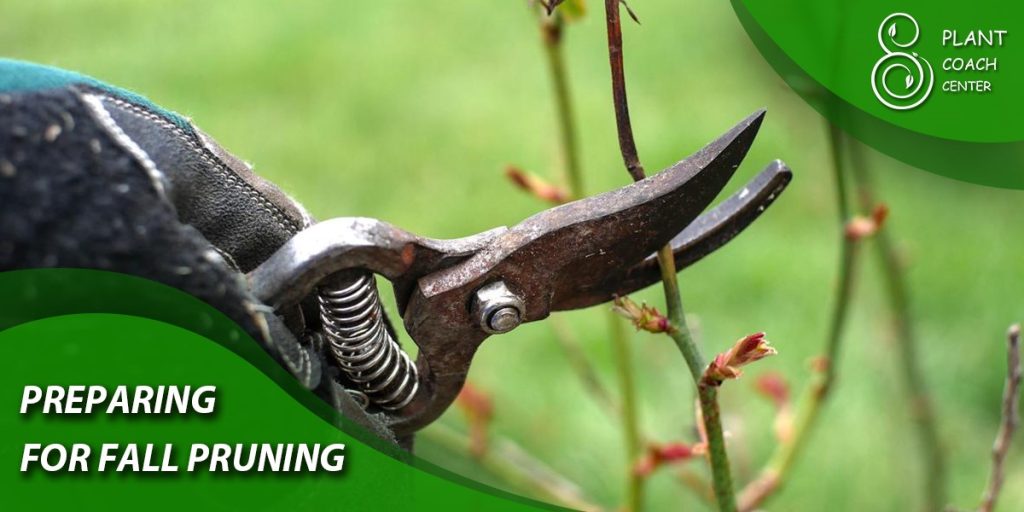
Preparing for Fall Pruning
To ensure successful fall pruning of your peonies, proper preparation is critical. Let’s explore the necessary steps to get ready for this critical task.
Tools and Equipment
Gather the right tools and equipment before you embark on your pruning journey. These will help you make clean cuts and minimize the risk of spreading diseases. Here are the essential items you’ll need:
- Pruning shears: Invest in a high-quality pair of sharp, bypass pruning shears. They have curved blades that slide past each other, providing clean cuts without crushing the stems.
- Disinfectant: To prevent the spread of diseases, sterilize your pruning tools before and after each use. You can use a solution of one-part bleach to nine parts water or a disinfectant specifically designed for gardening tools.
- Gloves: Wear sturdy gardening gloves to protect your hands from scratches and thorns. Opt for a pair that offers comfort and agility, allowing you to maneuver quickly while handling your peonies.
- Trash bag or bucket: Keep a bag or bucket nearby to collect the pruned plant material. Proper disposal of the debris helps prevent the spread of diseases and pests.
Timing Considerations
Timing is crucial when it comes to the fall pruning of peonies. You want to ensure the plants have enough time to gather nutrients and store energy for winter dormancy. The ideal time to cut back peonies is after the first frost or when the foliage turns yellow or brown.
In most regions, this occurs in late September or early October. However, the timing may vary depending on your climate and the specific peony variety you have. Monitor the changing foliage and the weather to determine the best time to begin your pruning endeavors.
Assessing Plant Health
Before grabbing your pruning shears, take a moment to assess the overall health of your peonies. Healthy plants have vibrant green foliage and sturdy stems. Look for signs of disease, such as spots, discoloration, or powdery residue on the leaves. Check for any signs of pest infestations, like chewed leaves or webbing.
If you notice any signs of disease or pests, addressing those issues before proceeding with pruning is crucial. Treat any diseases promptly using appropriate fungicides or organic remedies, and consider implementing integrated pest management strategies to manage pest populations.
By conducting a thorough assessment and addressing any underlying issues, you ensure that your peonies enter the winter season in the best possible condition, setting them up for success in the following year’s growth cycle.
Signs It’s Time to Cut Back Peonies
Knowing when to cut back your peonies in the fall is crucial for their overall health and successful pruning. By paying attention to the following signs, you can determine the perfect timing to begin your pruning efforts.
Recognizing Dormancy
Peonies naturally go through a dormant period during the winter months. The plants prepare for this restful phase as the weather cools and daylight hours decrease. One of the indicators that it’s time to cut back on your peonies is when they enter dormancy.
Observe the foliage closely as the season progresses. The peony is transitioning into dormancy when the leaves turn yellow or brown and show declining vitality. The onset of dormancy is a reliable cue to initiate your fall pruning.
Evaluating Foliage and Stem Conditions
Another critical factor in determining the right time to cut back peonies is assessing the condition of the foliage and stems. Look for the following indicators:
- Foliage discoloration: The leaves will gradually change color as the peony plant prepares for dormancy. They may turn yellow, brown, or even reddish before eventually withering. When you notice a significant shift in foliage color, it’s a sign that the plant is ready for pruning.
- Foliage dieback: Watch for the natural dieback of the foliage. The leaves will decline, losing their vibrancy and becoming droopy or shriveled. Once the majority of the foliage has withered, it’s an indication that it’s time to cut back the peonies.
- Stem condition: Assess the health of the stems as well. Look for any signs of damage, disease, or pest infestations. If you notice any issues, such as discolored or weakened stems, it’s essential to address them before pruning. Trim away any damaged or diseased portions of the stems, leaving only healthy sections for the winter.
Monitoring Bloom and Seed Pod Development
Peonies’ blooming and seed pod development stages can also guide your pruning timeline. Typically, after the peony has finished flowering, it will begin to form seed pods. These pods develop on the stems and contain the peony seeds.
If you’re interested in collecting seeds for propagation, allow the seed pods to mature on the plant. Once they have ripened and turned brown, you can collect them. However, if you’re not interested in seed production, removing the seed pods during fall pruning is generally recommended. This encourages the plant to redirect its energy into root and foliage development, resulting in healthier blooms the following year.
By considering these signs – the onset of dormancy, foliage, stem conditions, and the development of seed pods –, you can determine the most suitable time to cut back your peonies in the fall.
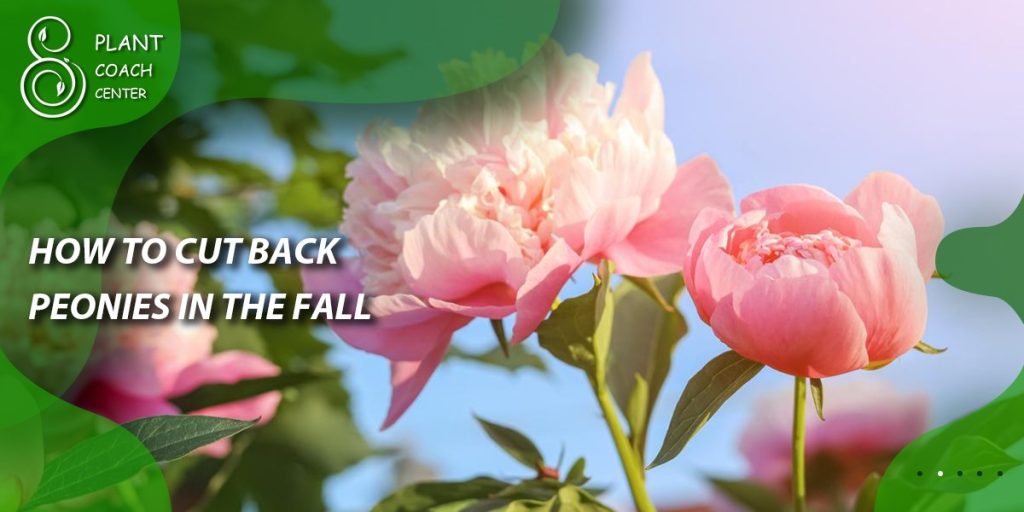
Step-by-Step Guide: How to Cut Back Peonies in the Fall
Pruning peonies in the fall involves specific techniques tailored to different peony types. Whether you have herbaceous or tree peonies, follow these step-by-step instructions to ensure a successful pruning session.
Pruning Techniques for Herbaceous Peonies
- Sterilizing Pruning Tools:
Before you begin pruning, disinfect your pruning shears by wiping the blades with a cloth soaked in rubbing alcohol or a disinfectant solution. This helps prevent the spread of diseases between plants.
- Clearing the Surrounding Area:
Remove any debris, fallen leaves, or weeds around the peony plant. This creates a clean working environment and minimizes the risk of pests or diseases hiding nearby.
- Removing Above-Ground Stems:
Using your sterilized pruning shears, cut back the above-ground stems of the herbaceous peony. Trim them down to ground level, leaving no more than an inch above the soil surface. Make clean cuts at a slight angle to promote water drainage and prevent water from pooling on the cut surface.
- Dealing with Diseased or Damaged Foliage:
Inspect the foliage for any signs of disease or damage. If you notice any infected or damaged leaves, remove them by cutting them off at the base. Please dispose of the diseased foliage in a sealed bag or burn it to prevent the spread of pathogens.
Pruning Techniques for Tree Peonies
- Assessing Stem Health:
Before pruning a tree peony:
- Evaluate the overall health of the stems.
- Look for any dead, damaged, or weak branches that need removal.
- Focus on maintaining a balanced structure and improving airflow within the canopy.
- Trimming Back Damaged or Dead Branches:
Carefully remove dead, damaged, or weak branches using clean and sterilized pruning shears. Make clean cuts just above a healthy bud or lateral branch junction. This promotes proper healing and encourages new growth.
- Properly Shaping the Canopy:
Pay attention to the overall shape and structure of the tree peony. Aim for an open, balanced canopy by selectively removing crowded or crossing branches. This helps prevent branches from rubbing against each other, which can lead to wounds and potential entry points for diseases.
- Dealing with Pests and Diseases:
If you encounter any signs of pests or diseases, such as aphids or fungal infections, take appropriate measures to address them. Use organic pest control methods or targeted treatments to manage pests and apply fungicides to combat fungal diseases.
Remember, it’s essential to keep your pruning tools clean and disinfected between cuts and different plants to prevent the spread of diseases.
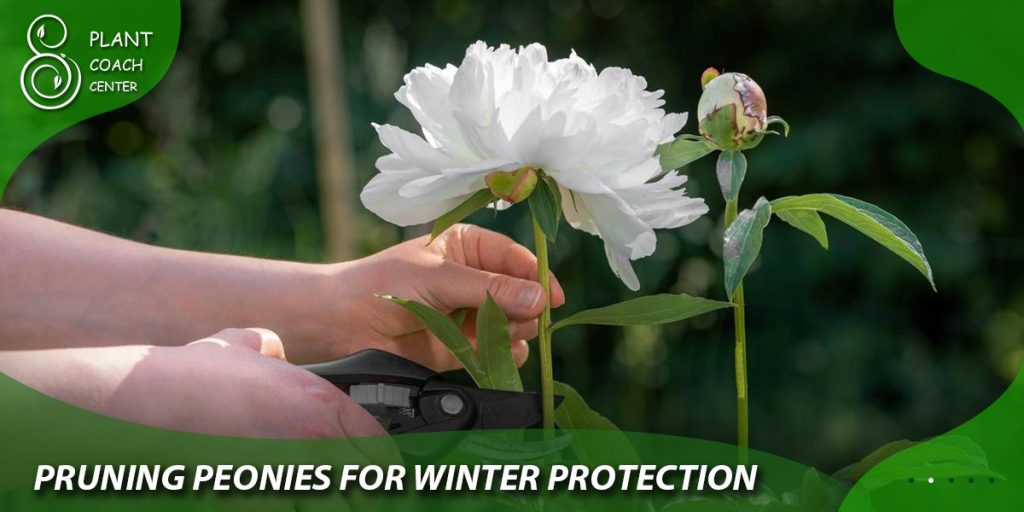
Pruning Peonies for Winter Protection
In addition to shaping and maintaining the health of your peonies, fall pruning also plays a crucial role in preparing the plants for the challenges of winter. Here are some essential techniques for winter protection after pruning
Mulching and Insulating Techniques
- Applying Mulch:
After pruning your peonies, apply a layer of mulch around the base of the plants. This helps insulate the soil and protect the roots from extreme temperature fluctuations during the winter. Organic materials such as straw, shredded leaves, or wood chips make excellent mulching options.
- Mulch Depth and Coverage:
Spread the mulch in a layer about 2-3 inches thick. Ensure the mulch covers the entire root zone of the peony plants, extending a few inches beyond the outermost stems. Avoid piling the mulch directly against the crowns of the peonies, as it can create a moist environment that promotes rot.
- Promoting Soil Drainage:
Peonies are susceptible to root rot if the soil remains waterlogged during winter. Before applying mulch, ensure that the soil around the peonies is well-draining. If the soil is heavy or prone to water retention, consider amending it with organic matter or using raised beds to improve drainage.
- Protecting Against Frost Heaving:
Frost heaving, where the soil freezes and thaws repeatedly, can cause peony roots to lift out of the ground, exposing them to potential damage. To prevent frost heaving, gently press down on the mulch after applying it to ensure it makes good contact with the soil. This helps stabilize the roots and keeps them insulated.
By implementing these mulching and insulation techniques, you provide your pruned peonies with the winter protection they need to survive the cold season and emerge strong in the following spring.
Troubleshooting Common Peony Problems
Like any other plant, peonies face various challenges throughout their growth cycle. By understanding and addressing common issues, you can ensure your peony plants’ optimal health and vitality. Let’s explore some of the most encountered problems and their solutions:
Pests and Diseases
- Identifying Common Pests
Peonies may attract pests such as aphids, spider mites, or nematodes. Look for signs of these pests, including distorted foliage, stippling, webbing, or yellowing leaves. Regularly inspect your plants to catch infestations early.
- Managing Fungal Diseases
Peonies can be susceptible to fungal diseases like botrytis blight or powdery mildew. To manage these diseases, adequate air circulation around the plants is ensured by spacing them adequately. Remove and dispose of any infected plant material, and apply fungicides if necessary.
- Preventing Viral Infections
Viral infections in peonies can cause mottled or distorted foliage, stunted growth, or deformed flowers. Unfortunately, there is no cure for viral diseases. Prevention is critical, so avoid introducing infected plants into your garden, and promptly remove and dispose of any infected plants to prevent the spread.
Nutrient Deficiencies and Soil Issues
- Recognizing Nutrient Deficiencies
Peonies may suffer from nutrient deficiencies like nitrogen, phosphorus, or potassium. Symptoms vary depending on the nutrient lacking, but common signs include yellowing leaves, stunted growth, or poor flowering. Conduct a soil test to identify and address deficiencies with appropriate fertilizers or soil amendments.
- Improving Soil Quality
Peonies thrive in well-draining, fertile soil. If your soil is heavy or lacks organic matter, consider incorporating compost, well-rotted manure, or other organic materials to improve its structure and nutrient content. This promotes healthy root development and overall plant vigor.
Environmental Factors
- Dealing with Excessive Heat:
Peonies can struggle in hot climates or during heatwaves. To protect your plants, provide afternoon shade or use shade cloth to shield them from intense sunlight. Adequate watering is essential during hot periods to prevent stress and dehydration.
- Coping with Cold Snaps and Frost:
Late frosts or sudden cold snaps can damage emerging peony shoots and buds. If frost is predicted, cover your peonies with blankets, frost cloths, or other protective coverings overnight. This helps insulate the plants and prevent frost damage.
By troubleshooting and addressing these common peony problems, you can create a healthier growing environment and promote the long-term success of your plants.
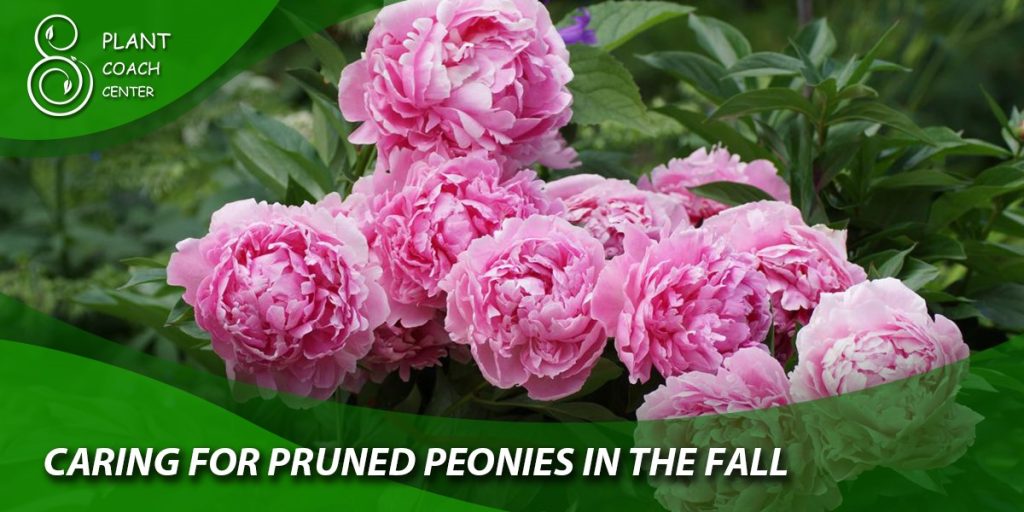
Caring for Pruned Peonies in the Fall
After pruning your peonies in the fall, it’s essential to provide them with proper care to support their recovery and prepare them for winter. Follow these steps to ensure the well-being of your pruned peonies:
Post-Pruning Cleanup
- Remove Pruned Plant Material:
Once you have finished pruning, gather and dispose of the pruned plant material. Seal it in a bag and discard it to prevent the spreading of diseases or pests. Do not compost any diseased or infested plant material.
- Clean the Surrounding Area:
Clear away any fallen leaves, debris, or pruned remnants from around the peonies. This helps eliminate potential hiding places for pests and diseases, reducing the risk of future problems.
Watering and Fertilization Guidelines
- Watering
Adequate hydration is crucial for the recovery of your pruned peonies. After pruning, please give them a deep watering to ensure the moisture reaches the roots. Continue to water as needed throughout the fall, ensuring the soil remains consistently moist but not waterlogged.
- Fertilization
In the fall, after pruning, you can apply a balanced slow-release fertilizer specifically formulated for flowering plants. Follow the manufacturer’s instructions for application rates and timing. This helps provide essential nutrients to support root development and prepare the peonies for the growing season.
Disease Prevention Measures
- Maintain Cleanliness
Practicing good garden hygiene is vital for disease prevention. Remove fallen foliage or plant debris promptly to reduce the likelihood of pathogens overwintering in your garden. Regularly sanitize your pruning tools to prevent the spread of diseases from one plant to another.
- Monitor for Signs of Diseases and Pests
Keep a watchful eye on your pruned peonies for any signs of diseases or pests. Early detection allows for prompt intervention and treatment. Inspect the foliage regularly and take appropriate action if you notice any abnormalities or symptoms.
By providing proper care and attention to your pruned peonies, you create favorable conditions for their recovery and prepare them for the challenges of winter. Your efforts during this post-pruning phase contribute to your peonies’ overall health and future blooming.
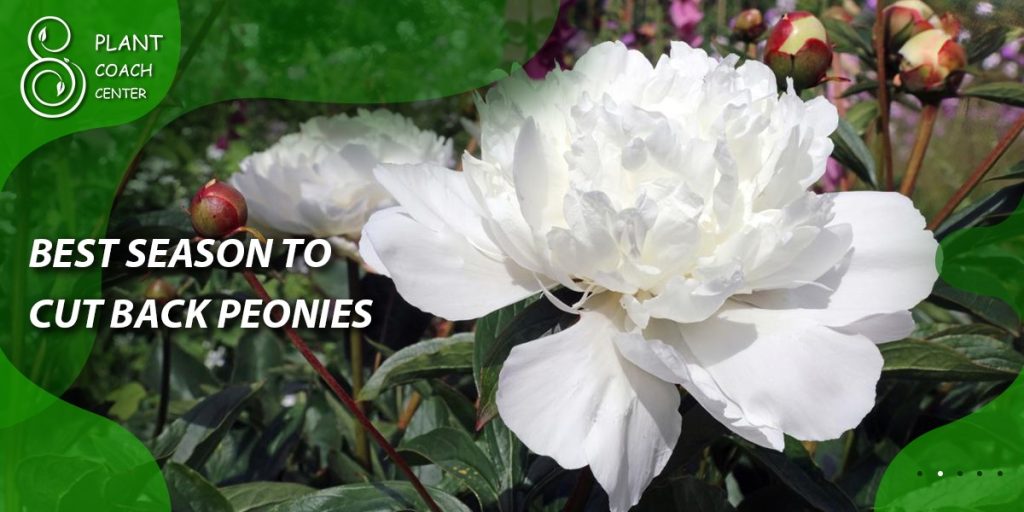
Conclusion
Pruning peonies in the fall is a crucial practice for maintaining these beautiful plants’ health, appearance, and blooming potential. You can successfully cut back your peonies in the fall by understanding the peony growth cycle, recognizing the signs for pruning, and following proper techniques. Remember to prepare adequately, address common peony problems, and provide post-pruning care to promote winter protection and set the stage for vibrant blooms in the coming seasons.
As you embark on your peony pruning journey, enjoy the satisfaction of nurturing these exquisite flowers and witnessing their stunning displays year after year.
Can I cut back peonies in the spring?
No, fall is the recommended time for pruning peonies.
Should I deadhead peonies in the fall?
Optional, but deadheading redirects energy for better growth.
How do I divide peonies in the fall?
Dig, separate, trim, and replant divisions for rejuvenation.







